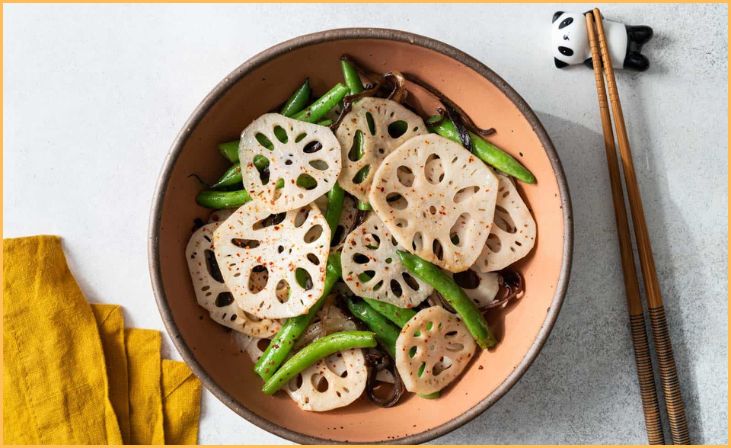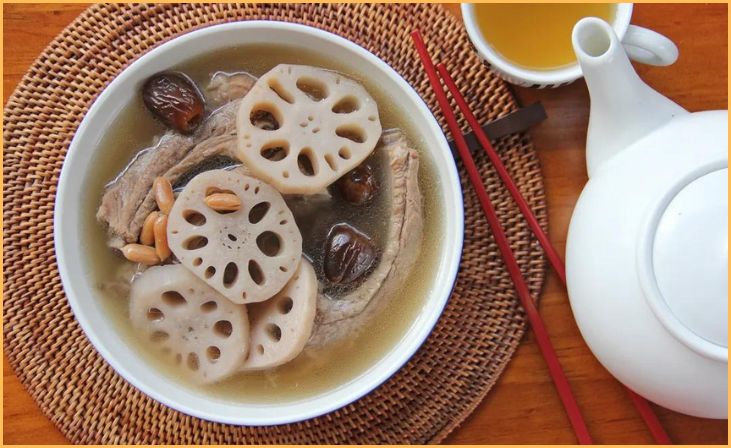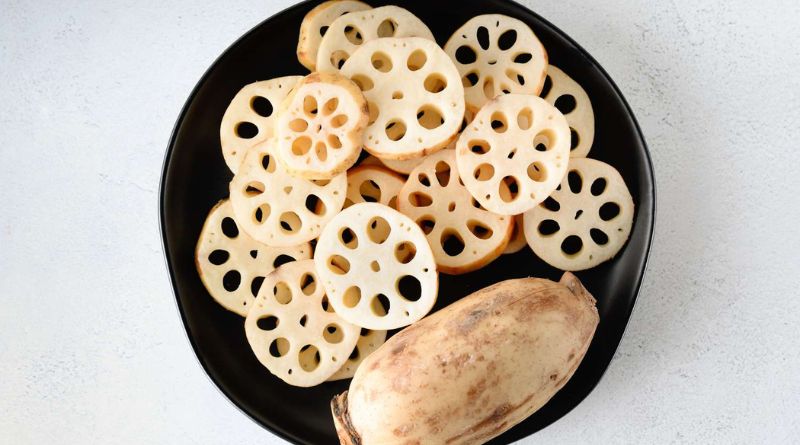Although known as a lotus root, it’s actually the rhizome of the lotus flower. These roots can grow quite long underwater and have segments linked like sausages. They are usually sold in shorter, more manageable portions and have become increasingly available at Asian stores. Low in calories and an excellent source of fiber, they have long been enjoyed in Asia for numerous health benefits that include high vitamin and mineral content. A traditional Chinese soup recipe of lotus roots boiled with peanuts is said to be good for the lungs.
- How to Start Online Gaming at Home: A Beginner’s Guide
- 10 Tips For Millennials Looking To Buy A Home In Singapore!
- Is Freehold Property Better Than Leasehold in Singapore?
- 10 Low-Calorie Salad Recipe Ideas to Keep You Energized
- 8 Irresistible Copycat Soups to Warm Your Soul!
What is Lotus Root?

Lotus is a plant native to Asia, Australia, New Guinea, and the Middle East. Because the lotus thrives in murky waters, it’s the lovely pink, purple, or white flower floating in shallow pools, lagoons, and marshes that you’ll commonly find represented in Buddhist paintings as a sign of enlightenment. Although the surface may not appear particularly delicious because of its pale brown hue, when you slice the foodstuff into it, the interior’s lacy geometric perforations make the food shine.
One of the first documented harvests of lotus root took place centuries ago in Guangzhou, a region in southern China. However, in the Huadu region and town of Jingtang, these delicacies were extracted from the mud, washed, cooked, and served. People still harvest lotus roots around the Dongzhi Festival, the region’s Winter Solstice festival that follows the Chinese Lunar Calendar. According to legend, the first lotus blossomed nearby owing to He Xiangu, one of Chinese mythology’s Eight Immortals.
She gave the starving people lotus seeds, and from those plants sprang roots and a bountiful harvest of food that needed no work to cultivate and would renew the following year.
What Does Lotus Root Taste Like?
Lotus root tastes mild but delightfully sweet. When eaten raw, it has a crisp feel comparable to celery. When you bite into it, it has the same watery freshness as celery. It is also known as the underwater sausage because of the way the roots join. When cooked for a longer time, such as in stews, it acquires a texture similar to a potato. A variety of lotus roots names, including Sacred Water Lotus and Chinese Arrowroot.
Renkon is how the Japanese refer to it. The root, which has a moderately bitter, crunchy flavor comparable to jicama, may be consumed raw or cooked. It’s pretty flexible and may be eaten raw in salads, cooked in soups and stews, steamed as a side dish, or pan-fried. The darker a root becomes as it ages, so look for a solid, light-colored root and store it in the refrigerator.
How to Cook Lotus Root?

You can prepare lotus roots in many ways, including boiling, baking, or frying. However, stir-frying is one of the most traditional ways to cook lotus root because the soft yet crispy quality of the vegetable is preserved.
Boiling
It is recommended that the vegetable be cut crosswise into quarter-inch slices and placed in a pot of vinegar water brought to a boil for this procedure. Cook the lotus root slices for three to five minutes, or until crisp-tender, then add to a salad of mixed greens or serve over rice with soy sauce, rice vinegar, and sesame oil.
Baking
Slice them into thin chips, like you would a potato, and season them with your preferred seasonings, such as a blend of olive oil, salt, and other spices. Bake the slices for 20 to 22 minutes at high heat, flipping halfway during cooking.
Stir-Frying
To stir-fry lotus root, cut it crosswise into quarter-inch slices and cook for two to three minutes in a tiny quantity of oil over medium-high heat. To enhance the distinctive crunch of lotus root, add vegetables such as asparagus, snow peas, and carrots.
How to Store it?
Lotus roots should be fat, heavy, and firm. For freshness, the color should be light brown and there should be no bruises or cracks. You can store them for up to two weeks in the refrigerator if they are wrapped in paper towels or a damp cloth in a plastic bag, but they should be consumed within a week.
Lotus Root Soup Recipe

Lotus Root Soup
It’s a light, healthy, delicious soup made with lotus root, pork ribs, and groundnuts. The combination of ingredients gives the soup a unique taste. It is also a healthy soup containing only a few ingredients.
- 500 g Pork Bones in Ribs
- 400 g Lotus Roots
- 100 g Raw peanuts
- 20 g Large Pieces of Ginger
- 10 pieces Red Dates (Rinsed and soaked for 15 minutes )
- 2 tbsp Goji
- 2.5 Liter Water
- 1/4 tsp White Peppercorn
- 2 1/2 tsp Salt
Put the pork ribs in hot water to blanch them. Upon reaching a pale color and the water begins to boil, remove them. Place the ribs in cold water to wash them quickly.
Place the blanched pork ribs into a pot. By adding sufficient cold water, about 1 cm above the ribs, immerse the ribs in water.
Boil the water and simmer the ribs for 30 minutes.
Occasionally skim off the scum on the surface with a wire mesh strainer.
Take root and peel it off. Cut it into half-centimeter-thick pieces.
To soften the peanuts, soak them in water overnight.
Make sure the wolfberries are rehydrated and plump by soaking them.
Combine the lotus root, peanuts, red dates, white peppercorn, and ginger.
Cook for 90 minutes at a low temperature.
Add the wolfberries and salt.
Cook for another 15 minutes.
It’s time to taste the soup.
Bottom Line
In the realm of root vegetables, the lotus root stands out as a versatile and underappreciated culinary treasure. From its captivating appearance to its adaptable nature in the kitchen, this aquatic gem offers a journey of flavors and textures. As we conclude our exploration, let the lotus root inspire your culinary adventures, encouraging you to experiment with its unique qualities and integrate it into your favorite dishes. This unassuming root has the potential to elevate your dining experience while contributing to a diverse and well-balanced diet.
FAQs
Lotus root has a mild and slightly sweet flavor with a crisp texture. It can be enjoyed raw, sliced into salads, or cooked in various ways, such as stir-fries, soups, and tempura. Its versatility makes it a delightful addition to both savory and sweet dishes.
Absolutely. Lotus root is a low-calorie vegetable rich in fiber, vitamins, and minerals. It contains vitamin C, B vitamins, iron, and essential minerals like copper and manganese. Its nutritional profile contributes to digestive health, immunity, and overall well-being.
Lotus root can be enjoyed both raw and cooked. When raw, it adds a refreshing crunch to salads. However, cooking methods such as stir-frying, boiling, or steaming enhance its flavor and make it more palatable in various dishes.
Lotus root is commonly available in Asian grocery stores and is increasingly found in mainstream supermarkets. Look for it in the fresh produce section. If you have difficulty finding it locally, some online retailers may offer this versatile root vegetable for home delivery.
Also Check:
Copper Chef Titan Pan Reviews: Best Choice in Nonstick Pan







